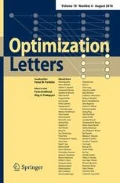Abstract
Over the past several years, researchers at the U.S. Air Force Academy developed cooperative, distributed aerial sensor networks (Pack et al. in IEEE Trans Syst Man Cybern Part B Cybern 39(4):959–970, 2009) using multiple small unmanned aerial vehicles (SUAVs) to search, detect, and locate ground targets. The use of distributed SUAVs, however, introduced a set of problems, including difficulties in reliable air-to-air communication and clock synchronization among onboard systems of multiple SUAVs. The communication problems further aggravate the synchronization problem contributing to a large target localization error. Conventional methods use multiple sensor outputs of the same target seen from different perspectives to increase the target localization accuracy. These methods are effective only when the pose errors of sensor platforms based on GPS data are modeled accurately, which is not a reasonable assumption for SUAVs, especially when SUAVs operate in an environment with wind gusts. In this paper, we propose a robust, novel technique that analyzes what we call ‘sensor fusion quality’ to assign an appropriate sensor reliability value to each set of updated sensor data. In the proposed approach, we characterize the quality of a set of newly acquired sensor data, containing a target, by examining the joint target location probability density function. The validity of the proposed method is demonstrated using flight test data.
Similar content being viewed by others
References
Bourgault, F. Furukawa, T., Durrant-Whyte, H.T.: Coordinated decentralized search for a lost target in a Bayesian world. In: Proceedings of the IEEE International Conference on Intelligent Robotic Systems, pp. 48–53 (2003)
Boyko N., Turko T., Boginski T., Jeffcoat D.E., Uryasev S., Zrazhevsky G., Pardalos P.M.: Robust multi-sensor scheduling for multi-site surveillance. J. Comb. Optim. 22(1), 35–51 (2011)
Cohen, I., Medioni, G.: Detecting and tracking moving objects for video surveillance. In: Proceedings of the IEEE International Conference on Computer Vision and Pattern Recognition (1999)
Enright, J.J., Frazzoli, E.: UAV routing in a stochastic, time-varying environment. In: Proceedings of the International Federation of Automatic Control World Congress (2003)
Jizhou, W., Zongjian, L., Chengming, L.: Reconstruction of buildings from a single UAV image. In: Proceedings of the International Society for Photogrammetry and Remote Sensing Congress, pp. 100–103 (2004)
Pack D., DeLima D., Toussaint G., York G.: Cooperative control of UAVs for localization of intermittently emitting mobile targets. IEEE Trans Syst. Man Cybern. Part B: Cybern. 39(4), 959–970 (2009)
Plett, G., Zarzhitsky, D., Pack, D.: Out-of-order sigma-point Kalman filtering for target localization using cooperating unmanned aerial vehicles. Advances in cooperative control and optimization. Lecture Notes in Control and Information Sciences, vol. 369, pp. 22–44 (2007)
Saripalli, S., Naffin, D.J., Sukhatme, G.S.: Autonomous flying vehicle research at the University of Southern California. In: Proceedings of the International Workshop on Multi-Robot Systems, pp. 73–82 (2002)
Uciński D., Patan M.: D-optimal design of a monitoring network for parameter estimation of distributed systems. J. Glob. Optim. 39(2), 291–322 (2007)
Vidal R., Shakernia O., Kim H.J., Shim D.H., Sastry S.: Probabilistic pursuit-evasion games: theory, implementation and experimental evaluation. IEEE. Trans. Robot. Autom. 18(5), 662–669 (2002)
Vincent, P., Rubin, I.: A framework and analysis for cooperative search using UAV swarms. In: Proceedings of the ACM Symposium on Applied Computing, pp. 79–84 (2004)
Yilmaz A., Shafique K., Shah M.: Target tracking in airborne forward looking infrared imagery. Image Vis. Comput. 21, 623–635 (2003)
Yoon, Y., Gruber, S., Krakow, L., Pack, D.: Autonomous target detection and localization using cooperative UAVs. Optimization and cooperative control strategies, lecture notes in control and information sciences 381(1) (2008)
Zarzhitsky D., Schlegel M., Decker A., Pack D.: An event-driven software architecture for multiple unmanned aerial vehicles to cooperatively locate mobile targets. Optim. Coop. Control Strateg. 462(8), 299–318 (2009)
Author information
Authors and Affiliations
Corresponding author
Rights and permissions
About this article
Cite this article
Kwon, H., Pack, D.J. Cooperative target localization by multiple unmanned aircraft systems using sensor fusion quality. Optim Lett 6, 1707–1717 (2012). https://doi.org/10.1007/s11590-011-0360-9
Received:
Accepted:
Published:
Issue Date:
DOI: https://doi.org/10.1007/s11590-011-0360-9




